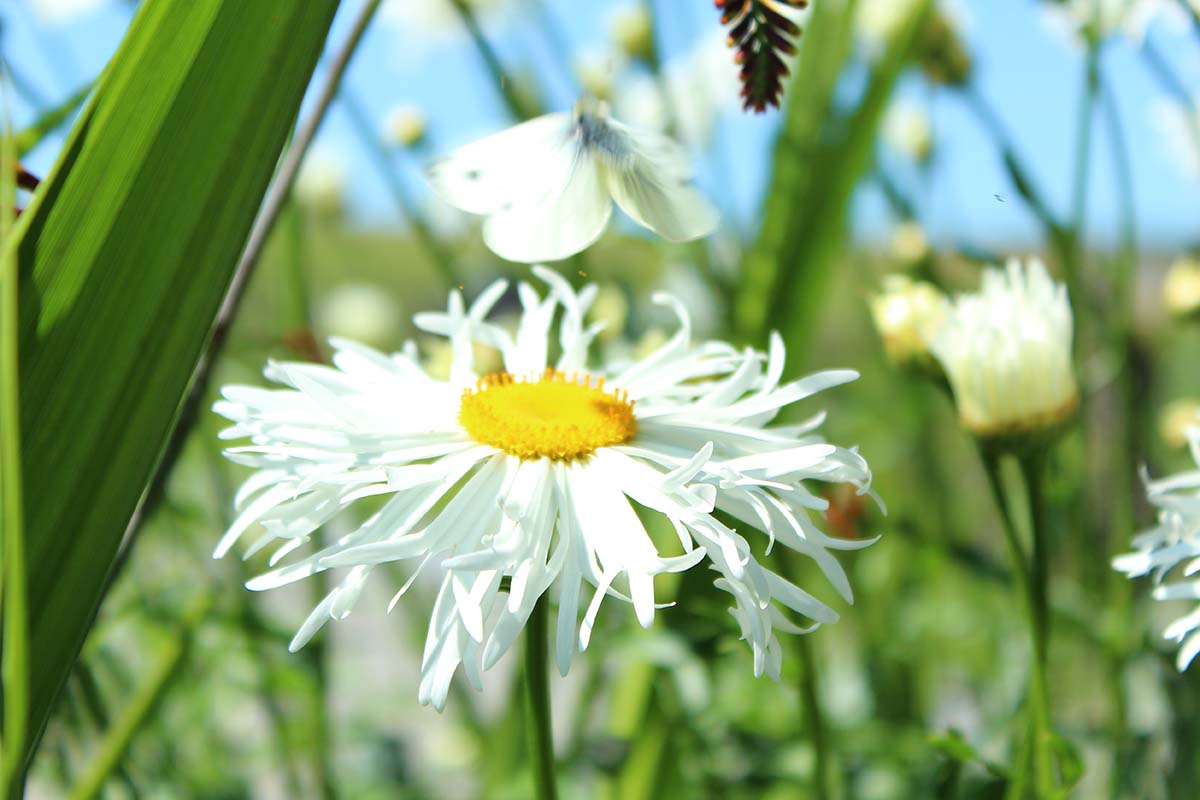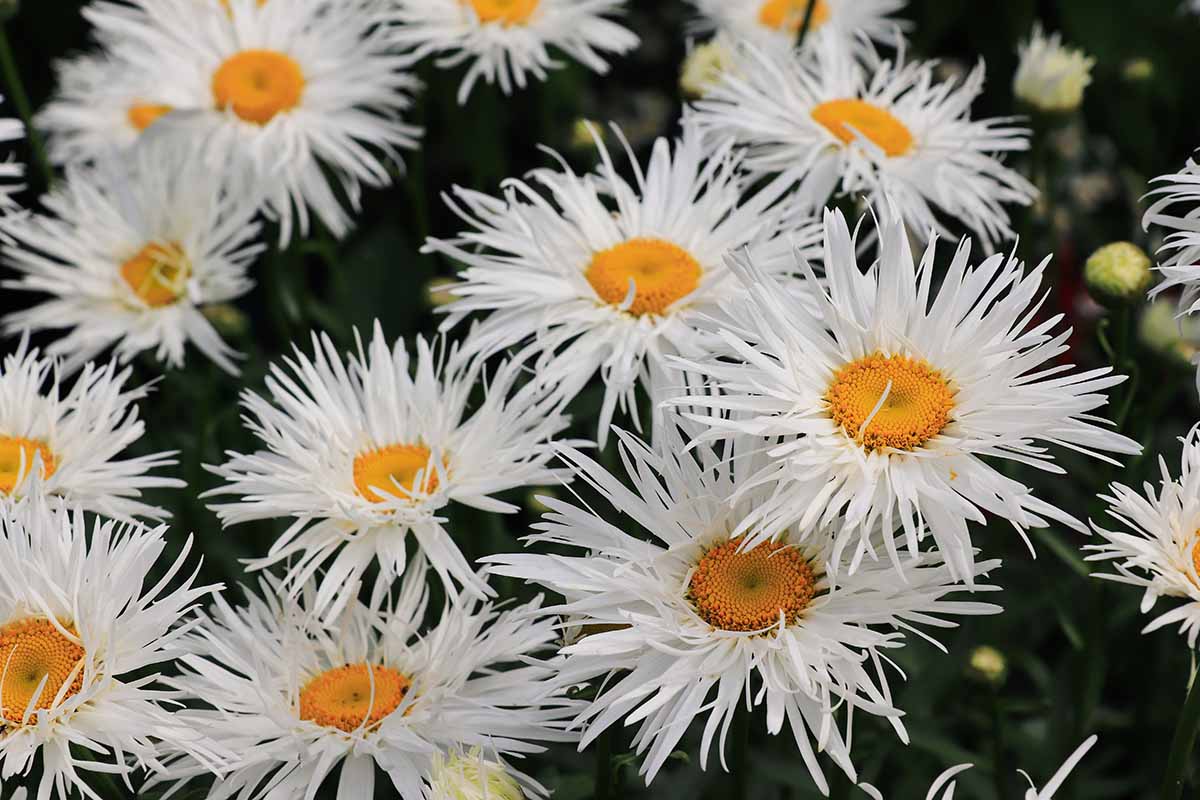We link to vendors to help you find relevant products. If you buy from one of our links, we may earn a commission. It can be frustrating when our plants struggle or refuse to bloom, especially if you are growing these beauties for cut flowers. If you need a refresher on how to grow Shasta daisies, check out our guide. In this article, we’ll discuss common reasons why your plants might not be blooming. First, let’s check if your plant is truly failing to flower or if it’s just not the correct time to expect blooms.
1. Timing
L. x superbum typically blooms from July to September. Although we may sometimes see blooms earlier or later, it’s important to assess whether it is the right time of year to expect these plants to flower before we dive into conducting a garden health check. If you are certain that it is the relevant time for your plants to be flowering and there is no sign of buds appearing, your plants may be experiencing one of the following issues.
2. Age
Shasta daisies need to be divided every two to three years to increase flowering. If this isn’t done, they will struggle to obtain adequate nutrients as they experience overcrowding at the crown and root level. Over time, they develop woody centers which produce few flowers in comparison to young soft shoots. In spring or late summer, you can lift your plant from the soil and divide the crowns using a sharp knife. Each new clump should have multiple stems and healthy roots attached. You can discard the spent woody center, which is unlikely to produce many flowers. Replant the divisions by digging a hole twice the width and depth of the root ball. This process will allow for plenty of breathtaking buds to come.
3. Overfertilization
You may notice weak and leggy stems, indicating they are trying to stretch into the sunlight to gain the energy the plants require to bloom. Shasta daisies may fail to flower if the nitrogen concentration in the soil is too high. High nitrogen levels in the soil will cause the plant to produce plenty of lush foliage, but instead of blooming, we will be left with a clump of leafy green stems that lack the showstopping flowers we adore. Luster Leaf Rapitest You will want to use a fertilizer with a NPK (or nitrogen, potassium, and phosphorus) ratio of 0-10-10 to kick off the growing season in spring. After this single application, it is best to refrain from applying any more later in the year. Liquinox Bloom Fertilizer
4. Too Little Sunlight
Shasta daisies should ideally be planted in full sun. If they are positioned in a space where they are not receiving enough sunlight, they may produce few, or no flowers at all. Moving your daisies is the best solution in this case. Transplant in spring or early fall, by lifting from the soil and replanting in well-drained, moderately fertile soil in an area that receives a minimum of six hours of full sunlight per day.
5. Extreme Temperatures
As gardeners, we cannot control the weather. But we can benefit from a better understanding of what these uncontrollable conditions can do to our plants. High temperatures will stress the plant and cause it to delay blooming until the temperature decreases to a more manageable range of 70 to 80°F. Frost and freezing temperatures, on the other hand, can cause damage to new growth and potentially destroy buds before they have a chance to open. A three-inch layer of mulch added around the base of the plant can help protect young shoots, but if new growth has already emerged beyond this level, an unexpected frost can cause damage.
6. Overwatering
These flowers enjoy free-draining soil and are known for being drought tolerant once established, so it’s no surprise that they don’t enjoy soggy conditions or standing water. For those growing in the garden, frost cloth applied to cover the plant can provide protection. Spun Bond Frost Blanket You can purchase frost cloth from Arbico Organics which is sold by the foot in a variety of different widths. Keeping an eye on the weather forecast in your area will help you in preparing for cold spells and allow you to protect your plants as needed. If you are overwatering your flowers, simply reduce the frequency with which you water and allow the plant to adjust to its new conditions. It’s also important that the soil is well-draining. If the area in which they are planted is the problem, you can help by lifting the plant and adding a shovelful of horticultural grit to improve drainage before replanting. You’ll need to keep a close eye on plants growing in containers, and make sure that there are adequate drainage holes in the bottom of the pots. If your pots are becoming waterlogged, you may consider repotting the plants and adding some coarse sand to improve drainage.
7. Root Rot
Typically related to overwatering, Shastas are prone to root rot if they are growing in waterlogged soil. Pythium water molds cause the root system to suffer black rot, which can ultimately lead to the death of your plants. Aboveground symptoms can include slow growth, mushy stems, and wilted or yellowing foliage. If you recognize these symptoms you can lift the plant from the soil and check the roots. Cut off and discard any that are discolored or damaged, and replant in free-draining soil. In the case of extensive damage, you’ll need to dispose of the plant. Make sure not to place infected plant material in your compost heap, as the pathogens may spread. If it’s already too late in the season, with proper care after adjusting your watering or fertilizing practices, transplanting to provide better sun exposure or increased drainage, dividing, or providing protection from extreme inclement weather, you should hopefully see a gorgeous flush of blooms next year. What issue were you having with your Shasta daisy? Let us know in the comments below! If you enjoyed this article, you may be interested to learn more about growing daisies at home in the following guides:
How to Prune Shasta DaisiesHow to Grow and Care for Gerbera DaisiesHow to Grow Cape Daisies (Osteospermum)







